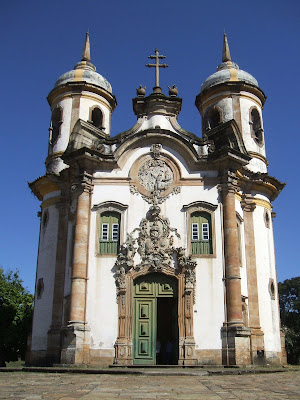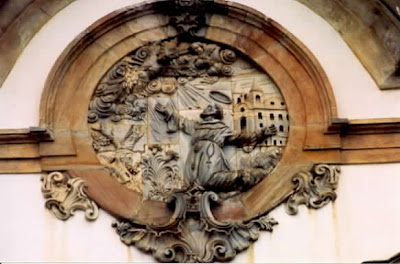Dear brothers and sisters:
The saintly Bishop Ambrose, of whom I will speak to you today, died during the night in Milan between April 3-4, 397. It was the dawn of Holy Saturday. The day before, toward 5 p.m., he began to pray as he was lying in bed with his arms open in the form of the cross. That is how he participated in the solemn Easter triduum, in the death and resurrection of Our Lord. "We saw him moving his lips," testified Paulinus, the faithful deacon who was invited by Augustine to write Ambrose's biography entitled "Vita," "but his voice could not be heard."
Suddenly, the situation seemed to come to an end. Honoratus, bishop of Vercelli, who helped Ambrose and who slept upstairs from him, was awakened by a voice that repeated: "Get up, quick! Ambrose is approaching death." Honoratus immediately went downstairs, Paulinus recounted, "and offered the saint the Body of the Lord. After having taken it, Ambrose surrendered his spirit, carrying with him viaticum. Thus, his soul, strengthened by virtue of that food, now enjoys the company of angels" ("Vita," 47).
On that Good Friday of 397, the open arms of the dying Ambrose expressed his mystical participation in the death and resurrection of Our Lord. This was his last catechesis: Without speaking a word, he spoke with the testimony of life.
Ambrose was not old when he died. He was not even 60, for he was born around 340 in Trier, where his father was prefect of the Gauls. The family was Christian. When his father died, and he was still a boy, his mother brought him to Rome to prepare him for a civil career, giving him a solid rhetorical and juridical education. Around 370, he was sent to govern the provinces of Emilia and Liguria, with headquarters in Milan. It was precisely there where the struggle between orthodox Christians and Arians was seething, especially after the death of Auxentius, the Arian bishop. Ambrose intervened to pacify those of both factions, and his authority was such that, despite the fact that he was nothing more than a simple catechumen, he was acclaimed by the people as bishop of Milan.
Until that moment, Ambrose had been the highest magistrate of the Roman Empire in northern Italy. Highly prepared culturally, but deficient in knowledge of Scriptures, the new bishop began to study them energetically. He learned to study and comment on the Bible from the works of Origen, the undisputed master of the school of Alexandria. In this way, Ambrose brought to the Latin environment the practice of meditating on Scriptures initiated by Origen, beginning the practice of "lectio divina" in the West.
The method of "lectio" soon guided the preaching and writing of Ambrose, which emerged precisely from prayerful listening to the word of God. A famous opening from one Ambrosian catechesis distinctly demonstrates how the holy bishop applied the Old Testament to Christian life: "When we read the histories of the patriarchs and the maxims of Proverbs, we come face to face with morality," the bishop of Milan told his catechumens and neophytes, "in order that, educated by these, you can then accustom yourselves to enter into the life of the fathers and to follow the path of obedience to the divine precepts" ("I misteri," 1,1).
In other words, neophytes and catechumens, in the opinion of the bishop, after having learned the art of living morally, could then consider themselves prepared for the great mysteries of Christ. In this way, the preaching of Ambrose, which represents the heart of his prodigious literary work, originates from the reading of sacred books ("The Patriarchs," the historical books, and "Proverbs," the sapiential books), to live in conformity with divine revelation.
It is evident that the personal testimony of the preacher, and the exemplarity of the Christian community, conditions the efficacy of any preaching. From this point of view a passage from St. Augustine's "Confessions" is significant. Augustine had come to Milan as a professor of rhetoric; he was a skeptic, not a Christian. He was looking, but he wasn't able to truly encounter the Christian truth. For the young African rhetorician, skeptical and desperate, it was not the beautiful homilies of Ambrose that converted him -- despite the fact that he appreciated them immensely. Rather, it was the testimony of the bishop and the Church in Milan, which prayed and sang, united as a single body. It was a Church capable of resisting the bullying of the emperor and his mother, who had demanded again the expropriation of a Church building for Arian ceremonies in early 386.
In the building that was to be expropriated, Augustine wrote, "the devout people of Milan stayed put, ready to die with their own bishop." This testimony in the "Confessions" is invaluable, because it shows that something was moving deep within Augustine. He continued, "Despite the fact that we were still spiritually lukewarm, we participated as well in the fervor of the entire population" ("Confessions" 9, 7).
From the life and example of Bishop Ambrose, Augustine learned to believe and to preach. We can refer to a famous sermon of the African, which deserved to be cited many centuries later in No. 25 of the dogmatic constitution "Dei Verbum": "All the clergy must hold fast to the sacred Scriptures through diligent sacred reading and careful study, especially the priests of Christ and others, such as deacons and catechists who are legitimately active in the ministry of the word. This is to be done so that none of them will become," and here is where Augustine is quoted, "'an empty preacher of the word of God outwardly, who is not a listener to it inwardly.'" He had learned precisely from Ambrose this "to listen inwardly," this diligence in reading sacred Scripture in a prayerful attitude, in order to truly receive it in one's heart, and to assimilate the word of God.
Dear brothers and sisters: I would like to present to you a type of "patristic icon" that, seen in the light of what we have just said, effectively represents the heart of Ambrosian doctrine. In the same book of "Confessions," Augustine recounts his meeting with Ambrose, certainly a meeting of great importance for the history of the Church. He writes in the text that when he came to see the bishop of Milan, the latter was always surrounded by hordes of people with problems, whom he tried to help. There was always a long line of people waiting to speak to Ambrose, looking for comfort and hope. When Ambrose was not with these people -- and this only happened for short periods of time -- he was either filling his body with the food necessary to live, or filling his spirit with reading. In this respect Augustine praises Ambrose, because Ambrose read Scriptures with his mouth closed, and only with his eyes (cf. "Confessions," 6,3).
In the early centuries of Christianity, reading Scripture was thought of strictly in terms of being proclaimed, and reading aloud facilitated understanding, even for the one who was reading it. The fact that Ambrose could read through the pages only with his eyes was for Augustine a singular capacity for reading and being familiar with Scripture. In this reading -- in which the heart seeks to understand the word of God -- this is the "icon" we are talking about. Here one can see the method of Ambrosian catechesis: Scripture itself, profoundly assimilated, suggests the content of what one must announce in order to achieve conversion of hearts.
Thus, according to the teachings of Ambrose and Augustine, catechesis is inseparable from the testimony of life. The catechist may also avail himself of what I wrote in "Introduction to Christianity" about theologians. Educators of the faith cannot run the risk of looking like some sort of clown, who is simply playing a role. Rather, using an image from Origen, a writer who was particularly appreciated by Ambrose, he should be like the beloved disciple, who rested his head on the Master's heart and there learned how to think, speak and act. In the end, the true disciple is he who proclaims the Gospel in the most credible and effective manner.
Like John the Apostle, Bishop Ambrose, who never tired of repeating "Omnia Christus est nobis!" -- Christ is everything for us! -- remained an authentic witness for the Lord. With these same words, full of love for Jesus, we will conclude our catechesis: "Omnia Christus est nobis! If you want to heal a wound, he is the physician; is you burn with fever, he is the fountain; if you are oppressed by iniquity, he is justice; if you need help, he is strength; if you fear death, he is life; if you desire heaven, he is the way; if you are in darkness, he is the light. ... Taste and see how good the Lord is. Blessed is the man who hopes in him!" ("De virginitate," 16,99). We also hope in Christ. In this way we will be blessed and will live in peace.
 Neroccio di Bartolomeo Landi (Siena 1447 - 1500)
Neroccio di Bartolomeo Landi (Siena 1447 - 1500)









